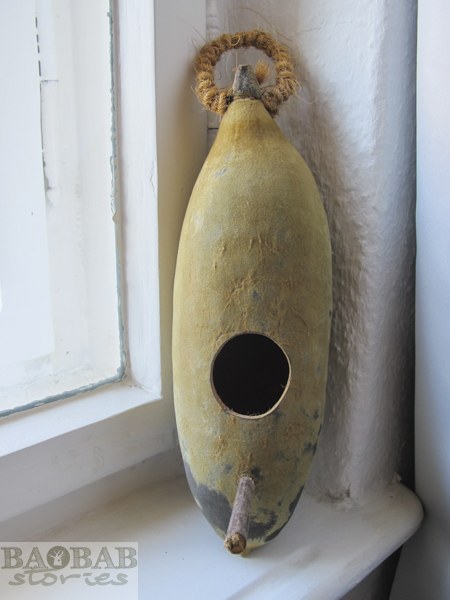Creative minds thought of another brilliant use of Baobab fruit pericarp – the outer shell of the fruit. Craftsmen in Shinyanga and Zanzibar in Tanzania create birdhouses out of fruit shells. The sale of the birdhouses is another innovative way for people living in areas with poor infrastructure to generate income and improve their living conditions.
A Tough “Nut” to Crack
Baobab fruit are up to 54 centimeters long, olive green and feel velvety when touched. The outer shell is about 5 millimeters thick and difficult to open. In order to get to the coveted and very tasty fruit powder and the seeds, one has to destroy the hard shell by sawing or smashing it open. In the production of birdhouses the shell remains largely intact. The fruit receives a circular hole on one side. The hole has a diameter of about five centimeters. The fruit powder and the seeds are removed. The “byproduct” birdhouse gets a peg of coconut or bast fibers on top to hang it on a tree or else. A little rod is attached below the hole for the birds to land and sit. The Baobab fruit birdhouses are sold by africrops (Berlin) or Baola (Munich).
The Baobab fruit pericarp was traditionally used as musical instruments, for example rattles. The seeds of the fruit are about a centimeter in size. Once the fruit powder is completely dry the seeds start to rattle against the pericarp when shaken. The same effect is achieved if a little hole is drilled at the top and the fruit thereafter filled with water and shaken. The fruit powder dissolves and can trickle out of the hole. The seeds remain in the shell and rattle when shaken.
Smaller Baobab fruit with shells intact are used as fishing floats – they indicate once a fish swallowed the bate and is caught on the hook.
Fruit of baobabs in Zanzibar have a very thick shell – it measures nearly a centimeter. Compared to the continental fruit these are round and slightly larger. Small bowls and other vessels are produced from the shell.
Baobab Fruits are Collected in the “Wild”
After flowering, the fruits need about six months to ripen on the tree. The fruit pulp dries in the pericarp while the fruit is still on the tree. The local population and the food and cosmetics industries benefit thereof. Once the fruit are ripe they fall off the trees and are gathered manually. Baobabs do not grow on plantations. The fruit are therefore called “wild collections”.
Baobab – “Super Fruit“
The precious fruit powder, which is traded internationally as “superfruit” or “superfood”, is natural. The powder is cleaned of fibers and seeds and finely sifted. No further processing is needed. The powder comes with a very high proportion of various important vitamins, minerals, trace elements, antioxidants and fiber and is very popular with people living a vegetarian or vegan diet. The seeds find their use in cosmetics. They provide valuable baobab oil, which has very special properties for skin care.


Hello are you buying organic baobab fruit ?
Thank you.
Dear Abdi Hassan, thank you for getting in touch. No, I do not buy baobab fruit – I do write about the trees. Good luck & all the best. Kind regards, Heike